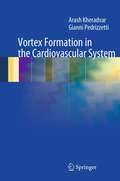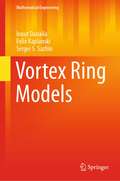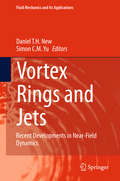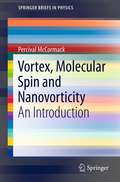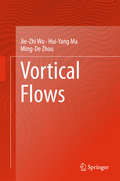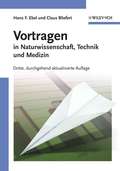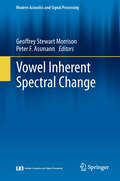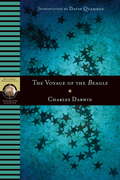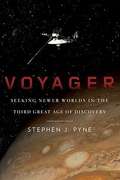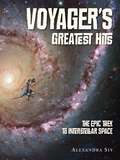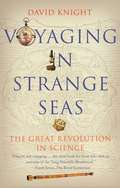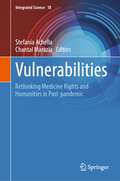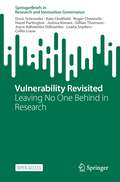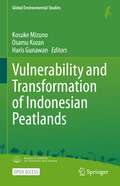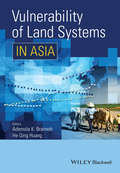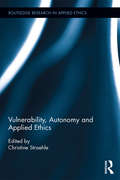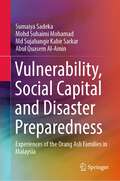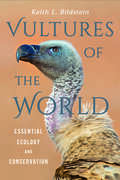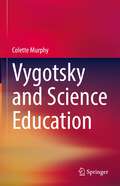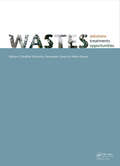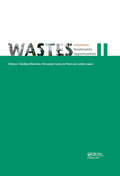- Table View
- List View
Vortex Formation in the Cardiovascular System
by Arash Kheradvar Gianni PedrizzettiVortex Formation in the Cardiovascular System will recapitulate the current knowledge about the vortex formation in the cardiovascular system, from mechanics to cardiology. This can facilitate the interaction between basic scientists and clinicians on the topic of the circulatory system. The book begins with a synopsis of the fundamentals aspects of fluid mechanics to give the reader the essential background to address the proceeding chapters. Then the fundamental elements of vortex dynamics will be discussed, explaining the conditions for their formation and the rules governing their dynamics. The main equations are accompanied by mathematical models. Cardiovascular vortex formation is first analyzed in physiological, healthy conditions in the heart chambers and in the large arterial vessels. The analysis is initially presented with an intuitive appeal grounded on the physical phenomena and a focus on its clinical significance.In the proceeding chapters, the knowledge gained from either clinical or basic science literature will be discussed. The corresponding mathematical elements will finally be presented to ensure the adequate diligence. The proceeding chapters ensue to the analysis of pathological conditions, when the reader may have developed the ability to recognize normal from abnormal vortex formation phenomenon. Pathological vortex formation represents vortices that develop at sites where normally laminar flow should exist, e.g. stenosis and aneurisms. This analysis naturally leads to the interaction of vortices due to the surgical procedures with respect to prediction of changes in vortex formation. The existing techniques, from medical imaging to numerical simulations, to explore vortex flows in the cardiovascular systems will also be described. The presentations are accompanied by the mathematical definitions can that be understandable for reader without the advanced mathematical background, while an interested reader with more advanced knowledge in mathematics can be referred to references for further quantitative analyses. The book pursues the objective to transfer the fundamental vortex formation phenomena with application to the cardiovascular system to the reader. This book will be a valuable support for physicians in the evaluation of vortex influence on diagnosis and therapeutic choices. At the same time, the book will provide the rigorous information for research scientists, either from medicine and mechanics, working on the cardiovascular circulation incurring with the physics of vortex dynamics.
Vortex Ring Models (Mathematical Engineering)
by Ionut Danaila Felix Kaplanski Sergei S. SazhinThis book offers a guide to understanding models of vortex rings, starting from classical ones (circular vortex filament, Hill and Norbury-Fraenkel inviscid models) to very recent models incorporating viscous effects and realistic shapes of the vortex core. Unconfined and confined viscous vortex rings are described by closed formulae for vorticity, stream function, translational velocity, energy, impulse and circulation. Models are applied to predict the formation number of optimal vortex rings and to describe two-phase vortex ring-like structures generated in internal combustion engines. The book provides a detailed presentation of analytical developments of models, backed up by illustrations and systematic comparisons with results of direct numerical simulations. The book is useful for graduate students in applied mathematics, engineering and physical sciences. It is a useful reference for researchers and practising engineers interested in modelling flows with vortex rings.
Vortex Rings and Jets
by Daniel T. H. New Simon C. M. YuIn this book, recent developments in our understanding of fundamental vortex ring and jet dynamics will be discussed, with a view to shed light upon their near-field behaviour which underpins much of their far-field characteristics. The chapters provide up-to-date research findings by their respective experts and seek to link near-field flow physics of vortex ring and jet flows with end-applications in mind. Over the past decade, our knowledge on vortex ring and jet flows has grown by leaps and bounds, thanks to increasing use of high-fidelity, high-accuracy experimental techniques and numerical simulations. As such, we now have a much better appreciation and understanding on the initiation and near-field developments of vortex ring and jet flows under many varied initial and boundary conditions. Chapter 1 outlines the vortex ring pinch-off phenomenon and how it relates to the initial stages of jet formations and subsequent jet behaviour, while Chapter 2 takes a closer look at the behaviour resulting from vortex ring impingement upon solid boundaries and how the use of a porous surface alters the impingement process. Chapters 3 and 4 focus upon the formation of synthetic jets from vortex ring structures experimentally and numerically, the challenges in understanding the relationships between their generation parameters and how they can be utilized in flow separation control problems. Chapter 5 looks at the use of imposing selected nozzle trailing-edge modifications to effect changes upon the near-field dynamics associated with circular, noncircular and coaxial jets, with a view to control their mixing behaviour. And last but not least, Chapter 6 details the use of unique impinging jet configurations and how they may lend themselves towards greater understanding and operating efficacies in heat transfer problems. This book will be useful to postgraduate students and researchers alike who wish to get up to speed regarding the latest developments in vortex ring and jet flow behaviour and how their interesting flow dynamics may be put into good use in their intended applications.
Vortex, Molecular Spin and Nanovorticity
by Percival MccormackThe subject of this book is the physics of vortices. A detailed analysis of the dynamics of vortices will be presented. The important topics of vorticity and molecular spin will be dealt with, including the electromagnetic analogy and quantization in superfluids. The effect of molecular spin on the dynamics of molecular nano-confined fluids using the extended Navier-Stokes equations will also be covered -especially important to the theory and applicability of nanofluidics and associated devices. The nanoscale boundary layer and nanoscale vortex core are regions of intense vorticity (molecular spin). It will be shown, based on molecular kinetic theory and thermodynamics, that the macroscopic (solid body) rotation must be accompanied by internal rotation of the molecules. Electric polarization of the internal molecular rotations about the local rotation axis -the Barnett effect - occurs. In such a spin aligned system, major changes in the physical properties of the fluid result.
Vortical Flows
by Jie-Zhi Wu Hui-Yang Ma Ming-De ZhouThis book is a comprehensive and intensive book for graduate students in fluid dynamics as well as scientists, engineers and applied mathematicians. Offering a systematic introduction to the physical theory of vortical flows at graduate level, it considers the theory of vortical flows as a branch of fluid dynamics focusing on shearing process in fluid motion, measured by vorticity. It studies vortical flows according to their natural evolution stages,from being generated to dissipated. As preparation, the first three chapters of the book provide background knowledge for entering vortical flows. The rest of the book deals with vortices and vortical flows, following their natural evolution stages. Of various vortices the primary form is layer-like vortices or shear layers, and secondary but stronger form is axial vortices mainly formed by the rolling up of shear layers. Problems are given at the end of each chapter and Appendix, some for helping understanding the basic theories, and some involving specific applications; but the emphasis of both is always on physical thinking.
Vortragen: in Naturwissenschaft, Technik und Medizin
by Claus Bliefert Hans F. EbelEin guter Vortrag ist nicht nur eine Sache der pers nlichen Begabung oder Ausstrahlung des Redners. Dahinter steckt mindestens genauso viel harte Arbeit und das n tige Wissen. Dieses Wissen um die beste Vortragstechnik haben die Autoren in unterhaltsamer Form zusammengestellt und sch pfen dabei aus ihrem eigenen reichen Erfahrungsschatz als Redner vor verschiedenstem Publikum. Die dritte Auflage dieses Standardwerks zum wissenschaftlichen Vortragen wurde im Hinblick auf die modernen Bildbearbeitungs- und Projektionstechniken durchgehend aktualisiert und erg nzt. Die perfekte Vorbereitung f r den ersten ffentlichen Vortrag, aber auch "alte Hasen" werden hier noch viel Neues entdecken. "au ergew hnlich lehrreich und doch nicht belehrend; die lockere Art der Darstellung [macht] das Lesen zu einer wahren Freude" (Nahrung / Food) "eine u erst hilfreiche Anleitung zur Bew ltigung technischer Klippen bereits weit im Vorfeld des ffentlichen Ernstfalles" (Physik in unserer Zeit) "beschreibt mit bestechender Gr ndlichkeit und gro em didaktischen Geschick, was bei der Vorbereitung und Durchf hrung eines Vortrags alles falsch gemacht werden kann und daher zu beachten ist" (Arzneimittel-Forschung)
Vowel Inherent Spectral Change
by Geoffrey Stewart Morrison Peter F. AssmannIt has been traditional in phonetic research to characterize monophthongs using a set of static formant frequencies, i.e., formant frequencies taken from a single time-point in the vowel or averaged over the time-course of the vowel. However, over the last twenty years a growing body of research has demonstrated that, at least for a number of dialects of North American English, vowels which are traditionally described as monophthongs often have substantial spectral change. Vowel inherent spectral change has been observed in speakers' productions, and has also been found to have a substantial effect on listeners' perception. In terms of acoustics, the traditional categorical distinction between monophthongs and diphthongs can be replaced by a gradient description of dynamic spectral patterns. This book includes chapters addressing various aspects of vowel inherent spectral change (VISC), including theoretical and experimental studies of the perceptually relevant aspects of VISC, the relationship between articulation (vocal-tract trajectories) and VISC, historical changes related VISC, cross-dialect, cross-language, and cross-age-group comparisons of VISC, the effects of VISC on second-language speech learning, and the use of VISC in forensic voice comparison.
Voyage of the Beagle
by Charles Darwin David QuammenCharles Darwin's theory of evolution and natural selection has been debated and disparaged over time, but there is no dispute that he is responsible for some of the most remarkable and groundbreaking scientific findings in history. His five-year trip as a naturalist on the H.M.S. Beagle took him on a journey to such exotic locales as Chile, Argentina, and the Galapagos Islands. Darwin wrote the details of this expedition, including his thoughts about the people on the ship and of course, his observations of the flora and fauna, in his journal, published as Voyage of the Beagle. It is here that his original interpretations of the Galapagos ecosystem and the impact of nature and selection are first revealed.
Voyager
by Pyne Stephen J.A brilliant new account of the Voyager space program-its history, scientific impact, and cultural legacy Launched in 1977, the two unmanned Voyager spacecraft have completed their Grand Tour to the four outer planets, and they are now on course to become the first man-made objects to exit our solar system. To many, this remarkable achievement is the culmination of a golden age of American planetary exploration, begun in the wake of the 1957 Sputnik launch. More than this, Voyager may be one of the purest expressions of exploration in human history. For more than five hundred years the West has been powered by the impulse to explore, to push into a wider world. In this highly original book, Stephen Pyne recasts Voyager in the tradition of Magellan, Columbus, Cook, Lewis and Clark, and other landmark explorers. The Renaissance and Enlightenment-the First and Second Ages of Discovery- sent humans across continents and oceans to find new worlds. In the Third Age, expeditions have penetrated the Antarctic ice, reached the floors of the oceans, and traveled to the planets by new means, most spectacularly via semi-autonomous robot. Voyager probes how the themes of motive and reward are stunningly parallel through all three ages. Voyager, which gave us the first breathtaking images of Jupiter and Saturn, changed our sense of our own place in the universe. .
Voyager's Greatest Hits: 8 Tracks for the Epic Trek to Interstellar Space
by Alexandra Siy2017 marks the 40th anniversary of the Voyager mission as the twin space probes that traveled to Jupiter, Saturn, Uranus, and Neptune, now journey beyond our solar system into interstellar space, where no probe has ventured before.Learn the fascinating story of the scientists, how the Voyager probes work, where the probes have been and what they&’ve seen, and what they carry on board—including the Golden Record, a recording of sounds and images about life on Earth. Critically acclaimed science writer Alexandra Siy chronicles the ongoing saga of the Voyagers in a lively story full of nail-biting moments, inspiring scientists, and incredible NASA images. An engaging and captivating STEM title that deserves a place in most libraries—School Library Journal STARRED REVIEWA lively, informative, and inspiring story of space exploration—Kirkus ReviewsA timely introduction to the Voyager mission—BooklistIt's an engaging and readily accessible account of a remarkable—and ongoing—scientific success story—Publisher's WeeklyChicago Public Library&’s 2017 Best of the Best Books selection
Voyager: Constellations of Memory
by Nona FernándezA startling book-length essay, at once grand and intimate, from National Book Award finalist Nona Fernández.Voyager begins with Nona Fernández accompanying her elderly mother to the doctor to seek an explanation for her frequent falls and inability to remember what preceded them. As the author stares at the image of her mother’s brain scan, it occurs to her that the electrical signals shown on the screen resemble the night sky.Inspired by the mission of the Voyager spacecrafts, Fernández begins a process of observation and documentation. She describes a recent trip to the remote Atacama desert—one of the world’s best spots for astronomical observation—to join people who, like her, hope to dispel the mythologized history of Chile’s new democracy. Weaving together the story of her mother’s illness with story of her country and of the cosmos itself, Fernández braids astronomy and astrology, neuroscience and memory, family history and national history into this brief but intensely imagined autobiographical essay. Scrutinizing the mechanisms of personal, civic, and stellar memory, she insists on preserving the truth of what we’ve seen and experienced, and finding ways to recover what people and countries often prefer to forget.In Voyager, Fernández finds a new container for her profound and surreal reckonings with the past. One of the great chroniclers of our day, she has written a rich and resonant book.
Voyaging in Strange Seas
by David KnightIn 1492 Columbus set out across the Atlantic; in 1776 American colonists declared their independence. Between these two events old authorities collapsed--Luther's Reformation divided churches, and various discoveries revealed the ignorance of the ancient Greeks and Romans. A new, empirical worldview had arrived, focusing now on observation, experiment, and mathematical reasoning. This engaging book takes us along on the great voyage of discovery that ushered in the modern age. David Knight, a distinguished historian of science, locates the Scientific Revolution in the great era of global oceanic voyages, which became both a spur to and a metaphor for scientific discovery. He introduces the well-known heroes of the story (Galileo, Newton, Linnaeus) as well as lesser-recognized officers of scientific societies, printers and booksellers who turned scientific discovery into public knowledge, and editors who invented the scientific journal. Knight looks at a striking array of topics, from better maps to more accurate clocks, from a boom in printing to medical advancements. He portrays science and religion as engaged with each other rather than in constant conflict; in fact, science was often perceived as a way to uncover and celebrate God's mysteries and laws. Populated with interesting characters, enriched with fascinating anecdotes, and built upon an acute understanding of the era, this book tells a story as thrilling as any in human history.
Vulnerabilities: Rethinking Medicine Rights and Humanities in Post-pandemic (Integrated Science #18)
by Stefania Achella Chantal MaraziaDrawing from a wide array of disciplinary perspectives and geographical contexts, this volume offers new insights for critically engaging with the problem of vulnerability. The essays here contained take the move from the COVID-19 pandemic, in order to explore the inherent vulnerability of individuals, but also of social, economic and political systems, and probe the descriptive and prescriptive import of the concept.Each chapter provides a self-contained perspective on vulnerability, as well as a specific methodological framework for questioning its meaning. Taken together, the chapters combine into a multi-disciplinary toolkit for approaching the various forms and structures of vulnerability, with a special attention to the intersectional factors shaping the individual experience of it: from gender to age, from disability to mental illness, from hospitalisation to incarceration. The book explores the theoretical richness and complexity of the concept and proposes new analytical approaches to it, before illustrating its multifariousness through empirically grounded case studies. The closing section engages with “the future of vulnerability”, as a hermeneutic, epistemological, and critical-normative perspective to be deployed beyond the domain of global crises and emergencies.The volume is primarily intended as a reference for scholars in the human, social and health sciences. The accessible structure and plain language of the chapters make it also a valuable didactic resource for graduate courses in philosophy, the social sciences and public health.
Vulnerability Revisited: Leaving No One Behind in Research (SpringerBriefs in Research and Innovation Governance)
by Doris Schroeder Roger Chennells Kate Chatfield Hazel Partington Joshua Kimani Gillian Thomson Joyce Adhiambo Odhiambo Leana Snyders Collin LouwOpen access. This open-access book discusses vulnerability and the protection-inclusion dilemma of including those who suffer from serious poverty, severe stigma, and structural violence in research. Co-written with representatives from indigenous peoples in South Africa and sex workers in Nairobi, the authors come down firmly on the side of inclusion. In the spirit of leaving no one behind in research, the team experimented with data collection methods that prioritize research participant needs over researcher needs. This involved foregoing the collection of personal data and community researchers being involved in all stages of the research. In the process, the term ‘vulnerability’ was illuminated across significant language barriers as it was defined by indigenous peoples and sex workers themselves. The book describes a potential alternative to exclusion from research that moves away from traditional research methods. By ensuring that the research is led by vulnerable groups for vulnerable groups, it offers an approach that fosters trust and collaboration with benefits for the community researchers, the wider community as well as research academics. Those living in low-income settings, in dire situations that are summarized with the term ‘vulnerability’ know best what their problems are and which priorities they have. To exclude them from research for their own protection is a patronizing approach which insinuates that researchers and research ethics committees know best. The team from this book have shown that minimally risky and minimally burdensome research tailored towards the needs of highly marginalized and stigmatized communities can be scientifically valuable as well as inclusive and equitable. I congratulate them. Prof. Klaus Leisinger, President Global Values Alliance, Former personal advisor to Kofi Annan on corporate responsibility
Vulnerability and Transformation of Indonesian Peatlands (Global Environmental Studies)
by Kosuke Mizuno Osamu Kozan Haris GunawanThis open access book deals with restoring degraded peatlands to help mitigate global warming, to which SDG 15 and SDG 13 are directly related. The book analyzes peatland degradation and restoration of the Indonesian peatland ecosystem through the integrated lens of resilience, vulnerability, adaptation, and transformation. It sheds light on what constitutes "resilience" of the peat swamp forest, digs deeper into local knowledge in developing the studies on institutions, governance, and ecological conditions that support the resilience of the peat swamp forest to elaborate on the idea of transformation in today's degraded peatlands. While peat swamp forests may be resilient, they remain highly vulnerable. The book analyzes restoration efforts through rewetting, revegetation, and rehabilitation of the local livelihoods with the concepts of adaptation and transformation. The integrated analysis covers fieldwork of more than a decade and various aspects such as agrarian and social changes, biological changes (birds, mammals, and termites), carbon emission, water control, timber use, revegetation efforts, and the Indonesia Sustainable Palm Oil (ISPO) program implementation. It also employs the ideas of vulnerability, resilience, adaptability, and transformation based on expanded studies on peatlands and observations of and participation in multiple efforts to prevent fires and restore the degraded peatland by researchers, the government, non-government organizations (NGOs), private companies, and last but not least, the local people. The discussion includes the period of pre-degradation and several efforts at peatland restoration for a better understanding and analysis of the long-term peatland dynamics.
Vulnerability of Land Systems in Asia
by Ademola K. Braimoh He Qing HuangThis book provides a comprehensive yet accessible overview of land systems vulnerability assessment in Asia - fundamental to the understanding of the link between global change, environmental sustainability and human wellbeing. The extent and intensity of human interactions with the environment have increased spectacularly since the Industrial Revolution. Thus, the global change research community and development practitioners increasingly recognize the need to address the adverse consequences of changes taking place in the structure and function of the biosphere and the implications for society. With a focus on Asia, this book provides an overview of the vulnerability of land systems and the subsequent multiple stressors in this region. The book offers a discussion surrounding the potential causal processes that affect land systems vulnerability and our capacity to cope with different perturbations. It also identifies factors that help to integrate vulnerability assessment into policy and decision-making. • Addresses the complex issues arising from human–environment interactions that cannot be satisfactorily dealt with by core disciplinary methods alone. • Key coverage of a variety of topics from the vulnerability of smallholder agriculture and urban systems to the impact of socioeconomic processes at the sub-regional level. • Coverage of the causal processes that affect land systems vulnerability and capacity to cope with different perturbations are documented. • Focus on integrating vulnerability assessment into policies and decision-making • Includes contributions from leading academics in the field.
Vulnerability, Autonomy, and Applied Ethics (Routledge Research in Applied Ethics)
by Christine StraehleVulnerability is an important concern of moral philosophy, political philosophy and many discussions in applied ethics. Yet the concept itself—what it is and why it is morally salient—is under-theorized. Vulnerability, Autonomy, and Applied Ethics brings together theorists working on conceptualizing vulnerability as an action-guiding principle in these discussions, as well as bioethicists, medical ethicists and public policy theorists working on instances of vulnerability in specific contexts. This volume offers new and innovative work by Joel Anderson, Carla Bagnoli, Samia Hurst, Catriona Mackenzie and Christine Straehle, who together provide a discussion of the concept of vulnerability from the perspective of individual autonomy. The exchanges among authors will help show the heuristic value of vulnerability that is being developed in the context of liberal political theory and moral philosophy. The book also illustrates how applying the concept of vulnerability to some of the most pressing moral questions in applied ethics can assist us in making moral judgments. This highly innovative and interdisciplinary approach will help those grappling with questions of vulnerability in medical ethics—both theorists and practitioners—by providing principles along which to decide hard cases.
Vulnerability, Social Capital and Disaster Preparedness: Experiences of the Orang Asli Families in Malaysia
by Abul Quasem Al-Amin Sumaiya Sadeka Mohd Suhaimi Mohamad Md Sujahangir SarkarThis book addresses increasing concerns regarding the relationship between social capital and disaster, highlighting conceptual definitions related to social capital and disaster, family, community, vulnerability, disaster experience, and preparedness. Focusing on a contemporary case of disaster management in Malaysia, the authors explore and establish linkages between the level of social capital and disaster preparedness among the indigenous Orang Asli people. Taking the case of the Orang Asli families as a point of departure, the book presents solutions for mobilizing social capital for disaster preparedness through multi-stakeholder involvement, promoting participation in awareness programs, ensuring indigenous people’s access to resources, and proposing a prioritization of local values and culture in enabling proper planning and coordination for more disaster-resilient communities in Malaysia, Southeast Asia, and beyond. The book is broadly relevant to cases in similar economic settings where indigenous people are lagging behind in disaster preparedness. An excellent resource for sociologists, this pioneering book collates various concepts and theories relating to social and ecological networks and systems, family resilience, and stress and coping mechanisms. It is relevant to researchers focused on disasters in developing countries, globally, particularly those focused on indigenous communities.
Vultures (Nature's Children)
by Tim HarrisWhere do vultures live? What do vultures eat? How big are vultures? Find out the answers to these questions and learn all about vultures physical characteristics, behavior, and habitats.
Vultures of the World: Essential Ecology and Conservation
by Keith L. BildsteinIn Vultures of the World, Keith L. Bildstein provides an engaging look at vultures and condors, seeking to help us understand these widely recognized but underappreciated birds. Bildstein's latest work is an inspirational and long overdue blend of all things vulture. Based on decades of personal experience, dozens of case studies, and numerous up-to-date examples of cutting-edge science, this book introduces readers to the essential nature of vultures and condors. Not only do these most proficient of all vertebrate scavengers clean up natural and man-made organic waste but they also recycle ecologically essential elements back into both wild and human landscapes, allowing our ecosystems to function successfully across generations of organisms. With distributions ranging over more than three-quarters of all land on five continents, the world's twenty-three species of scavenging birds of prey offer an outstanding example of biological diversity writ large. Included in the world's species fold are its most abundant large raptors—several of its longest lived birds and the most massive of all soaring birds. With a fossil record dating back more than fifty million years, vultures and condors possess numerous adaptions that characteristically serve them well but at times also make them particularly vulnerable to human actions. Vultures of the World is a truly global treatment of vultures, offering a roadmap of how best to protect these birds and their important ecology.
Vygotsky and Science Education
by Colette MurphyThis book highlights those aspects of Vygotskian theory which are most cogent to Science Education, including the Zone of Proximal Development (ZPD), concept development, play and imagination. Whilst these and other Vygotskian constructs apply to both research and practice in all forms of Science Education, this book employs a specific and critical focus on one or two key concepts for each context. Thus play and imagination are explored in depth in the chapter on science in early childhood learning, the ZPD is considered in depth in the primary school science chapter, and concept development in the secondary-level chapter. Chapters on higher education science learning and teaching, science teacher education, informal science learning, science education research, and the scientific endeavour itself draws on those aspects of Vygotskian theory which relate most closely. This book makes an important contribution to Vygotskian theory. Never before has it been applied so widely and comprehensively to the field of science and STEM education. The book is intended for students and academics in science and STEM education and the social sciences. It is also of interest to Vygotsky scholars and those involved in the analysis of pedagogic practice within and beyond science and STEM education.
WASTES 2015 - Solutions, Treatments and Opportunities: Selected papers from the 3rd Edition of the International Conference on Wastes: Solutions, Treatments and Opportunities, Viana Do Castelo, Portugal,14-16 September 2015 (Wastes: Solutions, Treatments and Opportunities)
by Fernando Castro Cândida Vilarinho Mário RussoThis volume presents a selection of papers from the WASTES 2015 conference, a platform for scientists and industries from the waste management and recycling sectors from around the world, who shared experiences and knowledge at the meeting. Covering discussions regarding the balance between economic, environmental and social outcomes, the development of innovative techniques, tools and strategies on how wastes can be transformed into good ideas. Improving both the overall environmental performance and the understanding of the industry impact on the environment, as well as the options analysis for its improvement were key objectives of this conference.
WASTES – Solutions, Treatments and Opportunities II: Selected Papers from the 4th Edition of the International Conference on Wastes: Solutions, Treatments and Opportunities, Porto, Portugal, 25-26 September 2017 (Wastes: Solutions, Treatments and Opportunities)
by Cândida Vilarinho, Fernando Castro and Maria de Lurdes LopesWastes: Solutions, Treatments and Opportunities II contains selected papers presented at the 4th edition of the International Conference Wastes: Solutions, Treatments and Opportunities, that took place 25-26 September 2017 at the Faculty of Engineering of the University of Porto, Porto, Portugal. The Wastes conference, which takes place biennially, is a prime forum for academics and industry representatives from the waste management and recycling sectors around the world to share their experience and knowledge with all in attendance. The published papers focus on a wide range of topics, including: Wastes as construction materials, Wastes as fuels, Waste treatment technologies,MSW management, Recycling of wastes and materials recovery, Wastes from new materials (nanomaterials, electronics, composites, etc.), Environmental, economic and social aspects in waste management and Circular economy.
WASTES: Selected Papers from the 6th International Conference Wastes 2023, 6 – 8 September 2023, Coimbra, Portugal (Wastes: Solutions, Treatments and Opportunities)
by Cândida VilarinhoWASTES: Solutions, Treatments and Opportunities IV contains selected papers presented at the 6th edition of the International Conference Wastes: Solutions, Treatments and Opportunities, that took place on 6-8 September 2023, in Coimbra, Portugal. The Wastes conference, which takes place biennially, is a prime forum for sharing innovations, technological developments and sustainable solutions for waste management and recycling sectors worldwide, with the participation of experts from academia and industry. The papers included in this book cover a wide range of topics, including: - Management of waste streams - Environmental, economic and social aspects in waste management - Logistics, policies, regulatory constraints and markets in waste management - Waste-to-energy technologies - Life cycle assessment and carbon footprint - Biological treatment techniques - Waste treatment and valorization technologies - Circular economy and industrial symbioses - Smart technologies and digital tools in waste management - Recycling of wastes and resources recovery - Wastes refineries - Food waste management and bioeconomy - Plastic waste impacts, management strategies and solutions - Wastes as critical raw materials resources WASTES: Solutions, Treatments and Opportunities IV is aimed at academics and professionals involved in waste management and recycling sectors globally.
